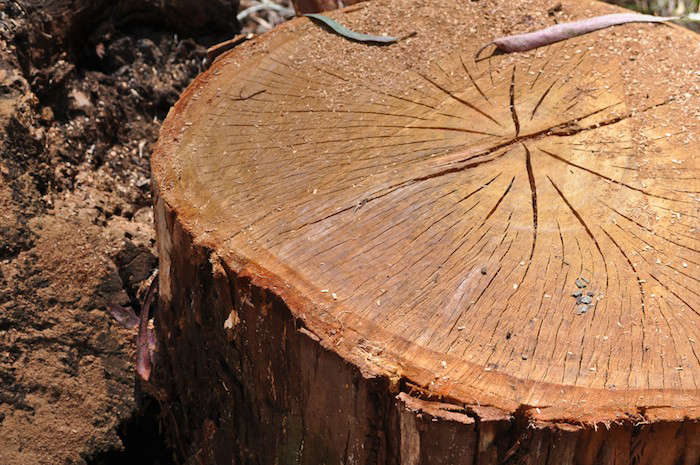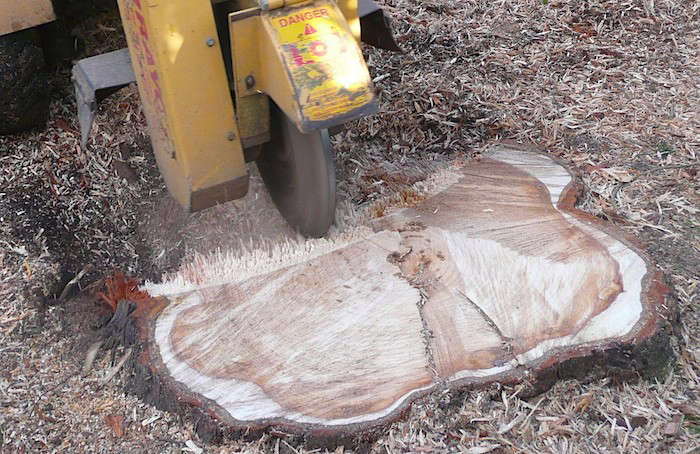It happens. Your long favored or ignored tree has to be removed. Disease, blocked views, size hazard, root damage, or just old age. The question arises: what to do about the stump? It comes down to three choices: use it, lose it, or camouflage it. Here’s what you need to know about the basics on the best way to handle that stump.
Above: A freshly cut eucalyptus stump shows the tree’s inner personality. Image by Janet Hall.
Why remove a tree stump?
The first decision is whether to let the stump stand. Considerations include:
- Aesthetics. Some find stumps unsightly, while others find them a visual feature. It depends on how well the stump blends into the landscape. Todd Lansing of San Francisco-based Creo Landscape Architecture and Design takes several items into account to make the decision: the location of the stump and whether it can be integrated into the design; the height of the stump (if it is too low, it is not useful and more of a hazard), and the type of tree and appearance as some tree stumps are better looking than others.
- Physical Hazard. Depending on the location of the stump, it can be a tripping hazard or get in the way of lawn mowers.
- Suckering. Stumps can generate new growth sprouts.
- Pests. A decaying stump can attract wood-boring insects that you don’t want near your house.
- Disease. Stumps, especially those of trees removed because of disease, can harbor fungal disease and the like that may harm neighboring trees or plants.
- Cost. Does the price of removing or grinding the stump fit your budget?
Above: Trees felled by Hurricane Sandy in the Brooklyn Botanic Garden. Photograph courtesy of Brooklyn Botanic Garden.
What are the best methods for tree stump removal?
Stump removal may seem straight forward, but it is not an easy task. The base and roots that have been keeping a large tree steady are not something that pop right out of the ground. There are four primary ways to remove a tree stump: mechanical, manual (digging), chemical, and natural decomposition.
- Mechanical Removal. Gone are the days of trying to pull the stump out of the ground with a truck and a chain. And, unless your stump is less than 4 inches in diameter, cutting it out of the ground is a very difficult task. Fast and effective, stump grinding is the method of choice. A stump grinder is a machine that uses a wide blade outfitted with teeth to grind the stump well below ground level. It creates wood chips or grindings that can be removed from the site or turned into the ground as mulch, though the volume of chips may to too much for the ground to handle.
Above: A stump grinder chews into a stump, reducing it to shavings. Image via Tom Kent Stump Removal. For information and prices for grinding stumps, see Tom Kent Stump Removal.
- Manual Removal. When does good old-fashioned digging work? If the stump is less than 4 inches in diameter or if you are dealing with a shrub stump, digging may work. Begin by digging a perimeter trench around the stump. The key is to have the right tools and to start farther out from the stump than you might expect. Use an axe, sharp spade, or even loppers to cut through the roots, working your way around the stump. Then loosen the soil and pry under the stump to try to get it out. Remember that even if you are successful, the stump may be very heavy and cumbersome to move.
- Chemical Removal. There are several chemicals available designed to speed up the rotting of a stump. Typically, holes are drilled into the stump and the chemicals are poured into the holes. After weeks or months, the stump will be soft and can be broken apart and removed. While faster than natural decomposition, this is still a very slow process. And then there is the toxic nature of the chemicals. Since they act both as a herbicide, which is poisonous, and to break down the wood fibers, it is safe to assume the products are not good for anything living. It is advised not to use this method when pets and children are present.
Above: A naturally decaying tree stump with ivy. Image by Janet Hall.
- Natural Decay. Not worried about a stump hanging around for awhile? Attracted to the natural wooded-look of a slowly decaying stump? Then ignoring it is a tried and true method. It will take years. The average stump takes from three to seven years to decompose. Hardwoods, like oak, take longer to decompose than other varieties. You can speed up the process by drilling holes into the stump, covering it with soil and watering it.
- Burning? Unless you live in a very remote location, this outdated method is not recommended due to air quality control issues and fire hazard. In fact, it is not allowed in most urban and many suburban locations.
Are some tree stumps harder to remove than others?
The variety of tree matters. “Some woods are fibrous. Pines and date palms fall into this category. While most people think their softness would make it easier to grind out, the opposite is true. The fibrous nature of the wood makes it more time consuming to remove. The density of hard woods actually can make it easier to grind,” explains Matthew Morgenstern, owner of East and West Bay Stump Removal. “Root systems also vary. Some are more surface-oriented, while others tend to go deeper. The varieties with extensive surface roots include Monterey pines, Liquidambars, maples, and poplars. These tend to require more extensive grinding.” Knowing the tree variety is also important in deciding whether to leave or remove the stump, as some varieties are more prone to producing suckers.
Can I remove a tree stump myself or should I hire a professional?
Complexity of stump removal depends on the size and variety of the tree, as well as challenges posed by its location. As mentioned above, DIY sump removal may be possible with small stumps and shrubs. When the stump is bigger enough to require mechanical removal, we advise seeking the help of a trained professional.
It’s not at all unusual for stumps to be located over gas lines or other utilities. These situations are best handled by an experienced equipment operator. “Renting equipment and doing it yourself is an option,” says tree stump removal professional Matthew Morgenstern. “Typical rental units are rather easy to tip over if you don’t know what to expect. Unexperienced operators should avoid uneven terrain at least until they have gained some confidence in how the machine responds. Lastly, stump removal equipment involves flying debris. Windows, cars, and onlookers are at risk without proper precautions.” Note that urban or small space situations may require special equipment as large machines can’t be used. Local professionals are likely to have the necessary expertise and equipment to handle different situations.
Above: Photograph courtesy of Brooklyn Botanic Garden.
How much does tree stump removal cost?
The factors affecting cost are the size of the stump and the accessibility. For machine grinding, many stump removal professionals charge by inch of the stump diameter. Expect a general price range around $3 per inch, with an understanding that there are many variables affecting each job. One such variable is accessibility for bringing in equipment. Removing a stump in my urban yard in San Francisco would be an expensive exercise (one estimate was $500) just to get the equipment into the back yard.
What are the alternatives to tree stump removal?
Scott Wheeler of San Francisco’s Urban Arborist recommends thinking twice before removing a stump unless you are trying to plant something in the same spot or if it is part of a bigger landscape re-design project. “Let it stand if possible,” he says. “It is expensive and intrusive to remove a stump. Think about alternative uses, like cutting the tree off at table height and using it as a table base, or carving the stump into a totem pole for your kids.”
Above: A Natural Tree Stump Side Table is $249 from West Elm.
Repurposing Tree Stumps
- As a Planter. Tree stumps can be effective planters for perennials, succulents, and woodland plants. Use its natural nooks and crannies or create hollows in the stump with a pickaxe or other tool to fill with dirt.
Above: Photograph by Douglas Lyle Thompson for Gardenista. For more of this garden, see Landscape Designer Visit: A “Showstopper” Backyard in Brooklyn.
- As a Decorative Element. Stumps can be sculptural in a natural garden.
- Other Inventive Uses. Stumps can be repurposed into table bases, stepping stools, seating, or even tree house foundations.
Camouflaging Tree Stumps
In many locations, tree stumps can be cut close to the ground and hidden within the landscape.
Above: Photograph by Janet Hall.
Clever camouflage of a large tree stump within a field of lavender. Last year my neighbor had to remove a large Monterey pine from the corner of her property. In consultation with the arborist, she choose to leave the stump as it is not close to her house and the disruption to her landscape of full stump and root removal would have been severe. They cut the stump as low to the ground as possible; the lavender plants have fully camouflaged the 3-foot-wide stump.
What to do with the scraps from your tree stump removal? They can be cut and used as stepping stones, small table tops, or as shown on Remodelista, an easy DIY Log Side Table.
Interested in tree preservation? See Surviving a Storm: Expert Tips From the Brooklyn Botanic Garden.





















Have a Question or Comment About This Post?
Join the conversation (8)